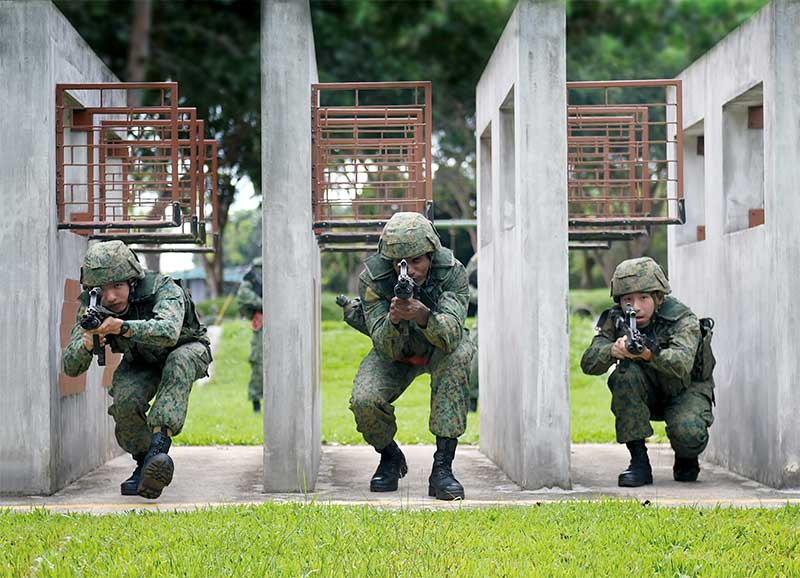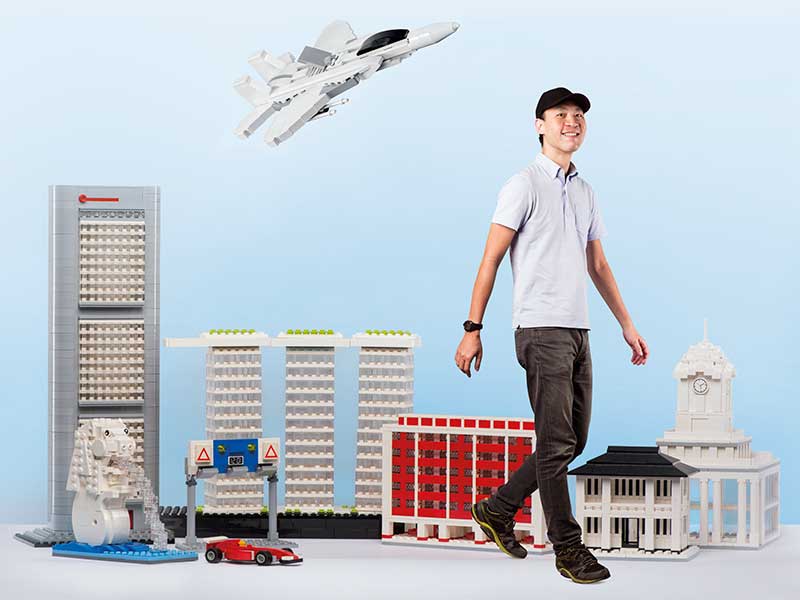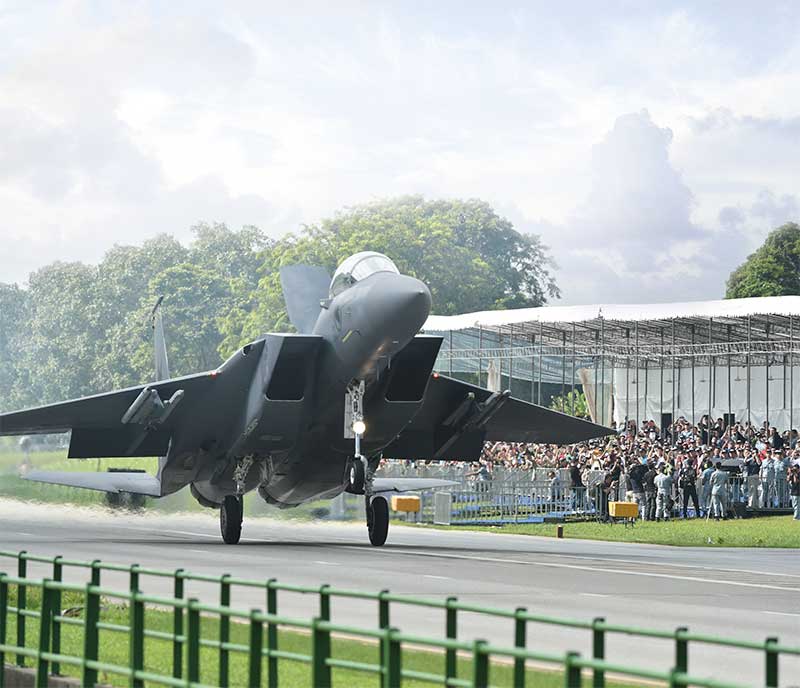The Basic Military Training Centre (BMTC) must be one of the most polite places in Singapore. Each utterance is likely followed by a crisp "Sir" and there is a lot of apologising followed by curious self-prostrations called push-ups. People tend to walk briskly here -- heads held high with their chests pushed out.
Located off the northeastern coast of the main island, Pulau Tekong is the site of the beginners' school for the Singapore Armed Forces (SAF) soldiers. For nine weeks, the new recruits will learn to work together as peers, cajole their weapons to fire true, and ultimately realise what it means to be a soldier of Singapore.
The brief remains the same as when National Service (NS) began in 1967 -- to train competent soldiers for the defence of Singapore. The way this is achieved, however, has evolved over the past 50 years.
Gone are the days of strict instructors who fill the recruits' days with punishments and scolding. While the training is still tough and realistic, they now spend more time explaining the drills and lessons.
Melting pot
Ask anyone who has been through BMT and they are almost certain to liken it to a microcosm of Singapore society.
There are the eager ones, the jokers and the absent-minded ones, who all come from different backgrounds. And they are all thrown into a life where almost every aspect is regimented and planned for in order to impart the necessary soldiering skills within the short nine weeks.
Life on the island begins early in the morning at 5am and ends at around 7pm if there is no night training.
Within those weeks, the ragtag civilians have to transform into a cohesive fighting unit. To achieve this, they are put through all manner of training which includes physical training sessions, weapon-handling drills and countless field lessons.
Learning with tablets
Recruits of today are issued tablet computers loaded with the LEARNet Portal system upon their enlistment. With these, recruits can preview and review the various modules, and even watch short video clips that help them to better understand the lessons.
"It's good in the sense that we don't go into any lesson totally blind," said REC Brandon Yue, 21, who found the weapon stripping and assembly modules most useful. The would-be soldiers are given time to access and complete key modules. They can even write about their experience in the portal.
Said 2nd Lieutenant (2LT) Javin Neo, who is one of the Platoon Commanders (PCs) at Orion Company: "It's also useful for commanders because we get to see which recruits are learning well or having adjustment issues."
Jungle training
Week Six arrives and some of the recruits are feeling a sense of dread. They are about to go on the five-day field camp where they will learn how to fight and survive in the jungle.
Those few days are expected to be tough because the recruits must learn to move silently and keep their faces camouflaged and their weapons close by at all times. It is a sticky and damp experience, to say the least.
"(Initially,) I found it hard to accept that I would be sleeping in the mud," admitted REC Mark Cheong.
Nightfall brings another set of challenges as the recruits have to complete all of their tasks in near pitch-black darkness.
"I never imagined the small things would get to me, like changing in the dark and trying to sort my things out in the dark," said REC David Liu.
"Crazily, you start to miss the bunks! Field camp put everything into perspective and I started to appreciate basic things like running water and electricity," he added.
Blowing hot and cold
Others have to contend with not only the lack of creature comforts but also physical reactions to the jungle heat. "I'm having heat rash all over my back, and some of my platoon mates are also uncomfortable, but we just have to push on," said REC Raihan.
To help recruits cope with the heat, ice-dips are carried out each day at noon during field camp. This is where the recruits submerge their forearms into a large tub of iced water for about 15 seconds and keep their arms raised above their heads for a brief period.
"Doing this cools the body rapidly as the (cooled) blood in their forearms circulates throughout the body," explained 2LT Neo.
Out in the field, even sleeping can be a problem. Night comes and temperatures drop. "I sleep at home with the air con on but this is too cold already!" said REC Yue who awoke from wind chill several times in one night.
Others found it easier to adjust, like REC Raihan: "I was so exhausted that I just slept. Looking back, it was quite comfortable and wasn't as bad as I thought it would be."
Taking shape
Day Four of field camp and the recruits face their field craft test. Everything that they have learnt in the past few days will now have to be put together to carry out basic combat drills.
What the testers look for is proficiency in executing the drills (various hand signals and verbal commands taught to them). It is not about mindlessly executing drills -- one of the tests calls for the recruits to assess the enemy's firepower and lead their section to either overrun the enemy or retreat.
"It's not as easy as it seems, we're all fatigued and we have to remember all the steps and execute them well," said REC Ahamed Ekhsan.
"But we do feel more like soldiers now. Being able to work together in a group to achieve an objective feels good."
It's not just a hole
Mention "field camp" and the word "shellscrape" is bound to come up. The most basic of field fortifications, a shellscrape is a shallow pit that allows the soldier to deliver fire while getting some cover from enemy fire. It is also where the recruits stow their field packs and spend the nights.
While recruits in the past used to construct field shelters called bashas, the curriculum has been updated to mirror actual operations where shellscrapes are used instead.
"During the demonstration (by the instructors), I thought how hard can it get?' It's just making a hole with the entrenching tool," said REC Raihan. The entrenching tool is a short-handled hoe carried by each soldier for basic earthwork.
That confidence soon gave way to fatigue. "After just 10 minutes of digging, it didn't feel so easy anymore," he said.
That is also the moment when the recruits' fighting spirit began to show. Some were clearly exhausted and exasperated, but no one was giving up.
And there were funny moments such as when two recruits were so focused on digging that they didn't realise they were dumping soil into each other's shellscrapes.
Digging deep
With hardship comes reflection. After field camp, many of the recruits told PIONEER that they now appreciated their families even more than before.
For REC Cheong, receiving a letter from home during field camp really touched him. "I wasn't expecting them to write to me as I was a very rebellious child growing up, who often got into heated fights at home," he said with tears welling up.
The recruits are given letters written by their families as a form of encouragement during field camp, and to remind them that they are training to defend their loved ones.
"My parents said that they knew I was tough enough to take the training and asked me to continue to work hard, and told me that they would be waiting for me at home," said REC Cheong.
"That was really sweet and it made me realise what a difficult child I must have been to raise. I'm really going to cherish my family more after this."
Overcoming SOC
Other than field camp, the Standard Obstacle Course is another fear-inducing part of BMT. Soldiers must overcome 12 obstacles in good time, with a 10m run to the obstacle course, followed by a 300m sprint to the finish.
"SOC was really more taxing than I thought it would be, especially with the added load," said REC Liu.
Soldiers go through the SOC wearing their helmets, integrated Load-Bearing Vests with filled water bottles and the Singapore Assault Rifle 21.
For recruits like REC Clarence Kee who have a fear of heights, the Balancing Beam and Apex Ladder were the most challenging. "I was super scared when I first went up the Balancing Beam, but my platoon-mates kept cheering me on."
He added: "I thought it would be over after I descended but he (the instructor) pushed me to go up again! Over time, I overcame the fear."
Higher aspirations
The SOC was, however, a breeze to recruits like REC Ganesh Selvapillay, 26, who used to be a fitness instructor at the Specialist Cadet School. He had served NS in the Singapore Civil Defence Force, but had made the decision to sign on as a Regular with the SAF.
"Though my fitness is there, there is still a lot for me to learn," said REC Ganesh. "I think I can do more than being a fitness instructor. My ultimate goal is to be an elite soldier... I'll keep trying until I make it into the Special Forces."
Another recruit who chose to go through BMT again was REC Justin Thong. He first enlisted in April 2016, but did not complete BMT due to a medical condition that got him posted to the 48th Battalion, Singapore Armoured Regiment as a store clerk.
After recovering from his condition, he requested to go for BMT again. "I just wanted to do something more to serve the country and not be stuck doing a mundane job when I'm physically fit," said REC Thong, who hopes to go to command school.
Just like my bro
Most of the recruits in Orion Company want to make it to the command schools after BMT and their levels of motivation are high.
"This being a leadership batch (of recruits), they stand a chance of becoming either Specialists or Officers," said Captain (CPT) Li Chun Leung, Officer Commanding (OC) of Orion Company.
For one particular recruit, the motivation also comes from his family. With an elder brother who is a BMT instructor and an Officer, REC Raihan feels the pressure to perform. "When he tells me stories from officer training, it sounds amazing and challenging at the same time. (So) I want to experience it for myself.
"What you get out of it (command school training), you can't buy with money."
Marching on
Week Nine and the recruits are getting pumped up for their 24km route march, the longest of the six marches they have to do during BMT.
As with all lessons in BMT, the training for route marches is carried out progressively. For the first few marches, the recruits are allowed to carry lighter loads or don thinner attire. This is done to make sure that the recruits grow stronger gradually and together as one.
The one who carries the morale of the platoon on a route march is usually the recruit assigned to lead the songs better known as the Song IC (In-Charge). "When we sing together, it takes the mind off the pain and it's much better," said Song IC REC Cheong.
For the final push from Changi to the Marina Bay area for their graduation parade, the recruits will not sing at certain points which are near residential areas. During those times, the recruits will have to rely on sheer willpower. "It's definitely going to be harder. We'll just have to get closer and really encourage each other," said REC Cheong.
Growing together
It is the last few days of their nine-week BMT and the recruits have become fast friends.
Even the laggards are trying their best. "I feel bad that it's me who often pulls the platoon down," said REC Kee.
The self-confessed heavy sleeper said: "I just cannot wake up and it's very embarrassing to have to rush down when everyone is ready and waiting for me so I try and work hard to be better."
Recalling the past weeks of training, the recruits shared some of the lighter moments.
In the first few weeks when they were still trying to adjust to military life, even donning the uniform proved to be a source of confusion. "We noticed one of our platoon-mates walking in a weird manner and discovered that he had put the wrong boot on the wrong foot!" said REC Ganesh.
Then there was the time when two recruits, assigned to each other as buddies, went round in circles looking for each other. "They ended up meeting each other on the staircase when one was going up and the other was going down.
"The whole platoon was laughing until we got scolded by our instructors," said REC Ekhsan with a chuckle.
Fast friends
Though the recruits don't say it, there is a sense of brotherhood. "Everyone makes mistakes, but what is more important is that all of us improve together," said REC Liu.
"You see everyone motivating each other to complete tasks, especially when it gets tough. That's really heart-warming."
Said REC Raihan: "I won't forget them (my platoon-mates), especially my section-mates.
I will always remember how we came together to achieve our goals. These people are family to me now."
The company of 230 recruits graduated on 10 Dec 2016 with a parade at the Marina Bay Floating Platform.
"As their OC, my biggest hope is that we have given them meaningful training," said CPT Li.
"They don't have to love NS but ultimately they have to see the need for it, and train to defend the country."





